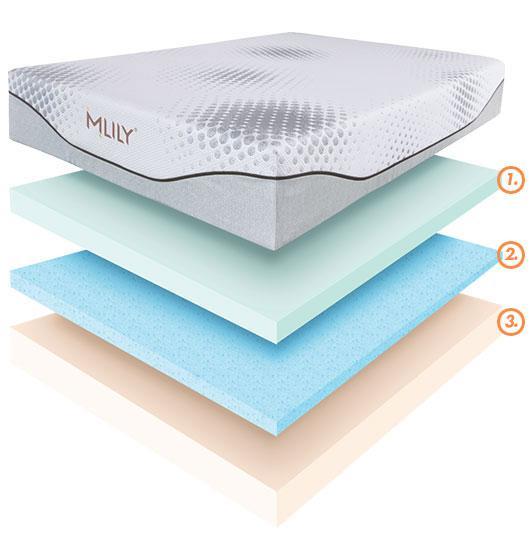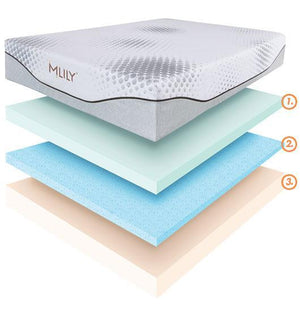10 Benefits of a Memory Foam Mattress.

by ROSIE OSMUN
Top Reasons People Chose Memory Foam Mattresses
If you are curious about memory foam beds, get to know the benefits these types of mattresses offer to see if one might be right for you.
1) Pressure Point ReliefThe newly innovated visco foam first translated into medical applications. Memory foam was introduced in the medical field to cushion, protect and comfort individuals in hospital intensive care units and in wheelchair seat cushions.
Essentially, when a person lays in position for a long time, the pressure of downward pulling gravity and upward resistance in bedding materials can affect circulation and damage soft tissues caught in the middle. The pressure-relieving benefits of memory foam were used to help prevent pressure sores and minimize pain in sensitive areas.
This is still one of the core benefits of memory foam beds. When you lay down on memory foam, the material yields and adjusts to your shape, rather than forcing you to contour to it. Unlike springs and other materials, memory foam does not “push back” or place added upward pressure on the sleeper.
2) Support Back/Spine AlignmentA memory foam mattress supports each part of the body evenly and individually by spreading your weight across the bed’s surface. The mattress contours to your body’s curves, supporting the lower back and allowing your spine to stay in a neutral position.
On other materials like springs, weight is typically concentrated on areas that contact the mattress. Typically, shoulders, hips and heels bear the brunt. For both back and side sleepers, this often means the the lumbar area is not adequately supported. Lower back pain and muscle tension can occur without critical support.
This displacement can also place the upper body at an unnatural position relative to your neck or legs, creating more tension and pain.
3) Relieve and Prevent PainThe unique combination of pressure point relief and support found in memory foam mattresses sets the stage for relieving current pain and preventing pain as well. The majority of memory foam mattress owners report reduced pain especially in the back, hips and shoulders in reviews.
The material is also a favorite of people with painful condition like arthritis and fibromyalgia. By supporting correct alignment, contouring to the body and not placing added pressure on sensitive areas, sleepers’ bodies can experience optimal comfort. Reduced pain is also associated with better sleep, offering another benefit.
4) Different Positions Can Be AccommodatedWhether you enjoy sleeping on your back, stomach, or side, a memory foam mattress can accommodate any position. Visco foam is designed to mold and cradle every part of your body evenly which allows you to settle into your most comfortable position without pressure points. There are also a wide range of firmness options available to accommodate different needs.
For back sleepers, memory foam curves to your spine, providing excellent lumbar support and allowing your back to relax. It works with side sleepers by accommodating hips and shoulders while still supporting your waist to keep your spine even. And for stomach sleepers, memory foam helps keep your back in shape and prevent painful pressure points.
5) Motion Doesn’t MatterMotion can make a lot of waves in traditional mattresses, which can mean disturbed sleep for couples. This can be a particular problem for couples with different schedules and for light sleepers.
One key benefit of a memory foam mattress is that the material absorbs motion and isolates rather than transferring it. When one person gets out of bed or rolls over, their partner isn’t bounced around or jolted out of sleep.
6) Dust Mite MitigationDust mites are an unavoidable fact of life. Pretty much every home has them, and one place they thrive is the bedroom. They are mostly harmless, however dust mites are one of the leading causes of indoor allergies.
A typical innerspring mattress may have anywhere from 100,000 to 10 million dust mites inside of it! The fluffy fiber padding and large open spaces make it easy for dust mites to burrow in, congregate, and collect in a traditional mattress.
The type of materials used and the dense structure of memory foam discourages dust mites more effectively. There simply aren’t as many places for them to live and thrive. Combining a memory foam mattress with hypo-allergenic mattress covers and regular surface vacuuming can help to control and mitigate dust mites in your bedroom.
7) Hypo-AllergenicFoam mattresses are great for allergy sufferers. Much as the dense nature repels dust mites, it also limits other allergens like mold and pet dander from working their way into the mattress.
The materials used are largely hypoallergenic (good for those with wool, feather, or other fiber allergies). Certain types of memory foam like Amerisleep’s plant-based Bio Pur material are low in VOCs, meaning they have little to no offgassing which is good for people sensitive to smells and harsh chemicals.
8) Perfect Fit for Adjustable BedsAdjustable beds have been growing in popularity over the past few years, and memory foam mattresses remain one of their most compatible partners. Memory foam readily flexes with the adjustable base and contours to the base’s different positions without compromising durability.
The nature of memory foam means that sleepers are supported and pressure points relieved whether the bed is angled or flat. Other types of beds like innersprings tend to be less flexible, and support and comfort can be compromised in different positions.
9) Easy to Care ForA memory foam mattress is a fairly low-maintenance commitment in terms of upkeep. These types of mattresses can benefit from rotating a few times per year and from occasional vacuuming, but that is the only maintenance the average user will need to do. There’s no monthly flipping/rotating required, no springs to bust, and no electronic parts to go haywire.
10) Good DurabilityThe other core benefit offered by memory foam mattresses is their good durability and lifespan. The average memory foam mattress lasts around seven years according to Sleep Like The Dead, with higher quality foams (higher density in the core and memory foam) lasting upwards of eight to ten years. In addition to lasting longer, memory foam is considerably less likely to sag compared to innersprings.
From lasting comfort to a cleaner bedroom, a memory foam mattress contributes to a better night’s rest in many ways. People who buy memory foam beds are also much more likely to report overall satisfaction than innerspring owners.
- Comfort for All




